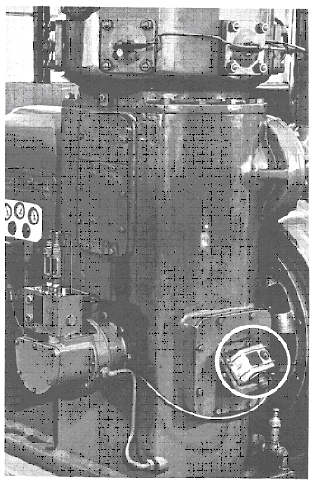Vibration Overview
TYPICAL VIBRATION SWITCH
INSTALLATIONS
TYPICAL INSTALLATION ON A MACHINE
The
photograph illustrates an installation of a Robertshaw vibration switch on a
reciprocating compressor. The sensing unit (detector) is placed on the
machine in a location that will permit the unit to be responsive to
excessive and damaging vibration. In this application the detector is
mounted on a heavy bracket which in turn is rigidly bolted to a heavy
inspection cover located opposite the main crank shaft and bearings of the
compressor. In this location the vibration switch will detect any excessive
vibration due to bearing wear or loose parts associated with either of the
two compressor pistons and their connecting rods which are driven by the
main crank shaft.
and damaging vibration. In this application the detector is
mounted on a heavy bracket which in turn is rigidly bolted to a heavy
inspection cover located opposite the main crank shaft and bearings of the
compressor. In this location the vibration switch will detect any excessive
vibration due to bearing wear or loose parts associated with either of the
two compressor pistons and their connecting rods which are driven by the
main crank shaft.
Typically, the detecting element is placed as close to the bearing
assemblies, crank shafts, driven gears and other rotating or reciprocating
parts as possible in order to be responsive the malfunctions of these
parts
APPLICATIONS
Nearly all rotating or reciprocation machines are
candidates for vibration measuring and control or alarm instrumentation.
The following list of machines are typical:

The types of failures these machines typically suffer most
often are

TYPICAL VIBRATION
SWITCH INSTALLATIONS

The line
drawing shown in Figure 5 indicates typical mounting locations for the
vibration switch detectors on a multiple unit machine
consisting of a diesel engine driving into a gear box which in turn is
driving a centrifugal compressor. A
vibration switch detector is mounted on each of the major units as
near the main drive bearings as
possible on both the centrifugal compressor and the gear box. The
diesel engine is protected by only a single vibration switch located at a
mid-point on the engine frame; better protection would be afforded with
additional detectors mounted on the engine at the ends of the engine near
the drive bearings.
Typical installation
of an explosion-proof vibration switch on a motor driven centrifugal
pumping unit. The circled area indicates the
mounting location of the vibration
switch on the centrifugal pump used in a petrochemical pipeline
installation at one of the pumping stations.
The drive motor is a 600 hp, 3500 rpm unit driving directly a high
pressure centrifugal pump operating at approximately 450 psig
pressure.

Multiple vibration
switch installations at a liquified petroleum gas production facility.
The unit circled at the extreme right of the photo-graph
shows an explosion proof vibration switch and associated control unit mounted
on the motor drive unit of a vertically driven pump. The vibration
switch is mounted approximately at the motor mid-point so that it will be
responsive to any excessive vibration of either the
motor or the vertical pump. The motor
drive speed is 4500 rpm. The
control unit is mounted on a free standing vertical panel along with
Start, Stop and Reset switches required by the system.
The circled areas to
the center and left of the photograph shows the installation of additional
vibration switch detectors on motor driven centrifugal pumps at this LPG
processing facility.
RECOMMENDED INSTALLATION LOCATIONS






See Also:
Understanding the Physical
Characteristics of Vibration
Vibration Switch Sensors
